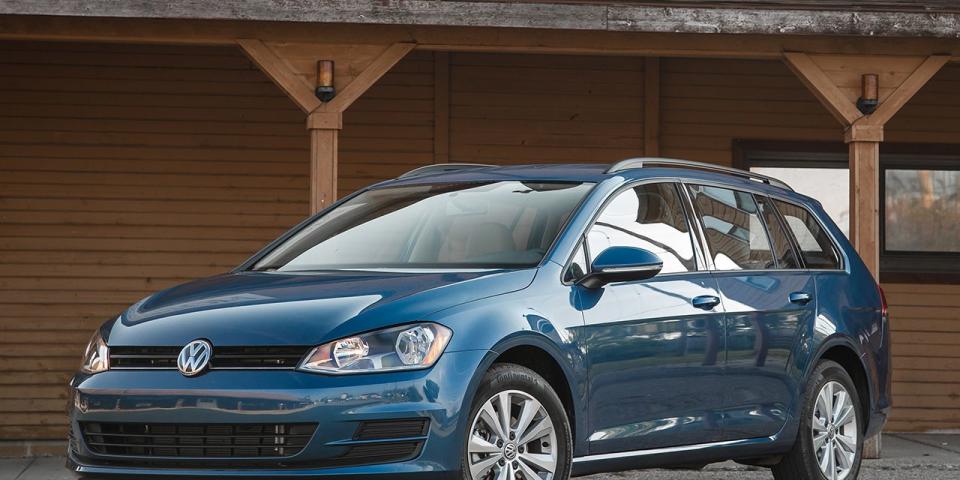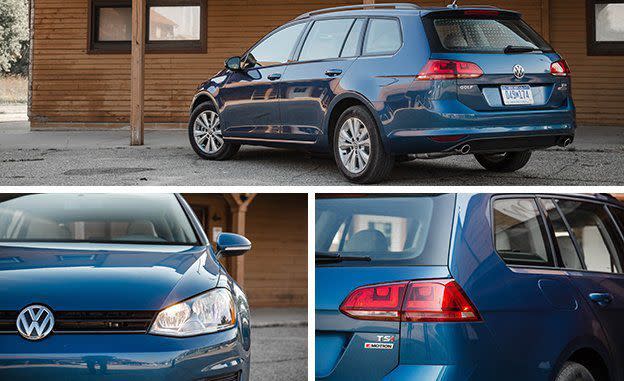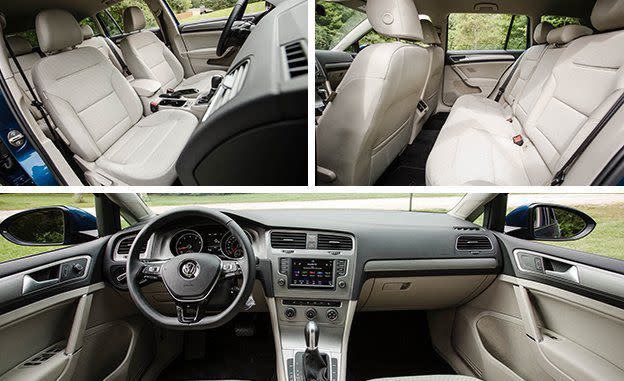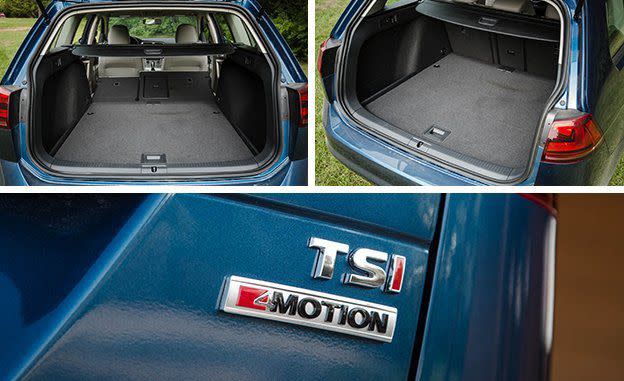2017 Volkswagen Golf SportWagen 4MOTION

With the rise of the crossover SUV, the small compact station wagon has had a hard time maintaining traction in the marketplace. People want a high-riding seating position, available all-wheel drive, and room for all the trappings of an active lifestyle, without sacrificing style. Since it replaced the Jetta wagon for 2015, the Volkswagen Golf SportWagen has checked some of those boxes, but for 2017 it adds another feature to its list-all-wheel drive-as well as the higher-riding Alltrack model.
Previously restricted to the European market, the SportWagen 4MOTION is now entering North American showrooms thanks to a retooling of Volkswagen’s manufacturing plant in Puebla, Mexico, allowing it to churn out both front- and all-wheel-drive variants. The AWD system utilizes an electronic coupler to send up to 50 percent of available torque to the rear axle when it senses or predicts front-wheel slip. While it’s certainly not configured for rock-crawling in Moab, it should be more than capable of tackling a snowy commute or the long, steeply inclined gravel driveway to your backwoods cabin.
Down and Dirty
The rain-soaked, mud-caked dirt roads south of the C/D office in Ann Arbor, Michigan, proved to be a perfect playground for a spirited drive. Volkswagen claims its 4MOTION system can shuttle torque rearward in just a fraction of a second; judging by the seat of our pants and by the electronic stability-control system never once intervening, that claim seems justified. Sharp throttle inputs were met with confident forward motion, even on the slipperiest roads.
In its default front-wheel-drive mode, the Golf SportWagen drives much like its hatchback stablemates. It’s comfortable, well-planted, and athletic. Throw the SportWagen into a corner and the extra weight it carries-both in the all-wheel-drive system and in the extra bodywork behind its rear axle-is barely noticeable. Adding AWD and switching from the standard SportWagen’s six-speed automatic to a six-speed dual-clutch transmission increases weight by an extra 94 pounds over the last front-wheel-drive Golf SportWagen we tested. Midcorner stability is just as good, and this 4MOTION-equipped SportWagen outgripped the front-wheel-drive variant on our skidpad by 0.03 g, pulling 0.85 g.
Despite the weight penalty, all-wheel drive also benefits acceleration. The SportWagen 4MOTION managed a run from zero to 60 mph in 7.0 seconds, 0.8 second ahead of its front-wheel-drive counterpart. It made it through the quarter-mile in 15.5 seconds, which is 0.4 second quicker than its FWD stablemate but at the same 89 mph trap speed. Credit the 4MOTION system’s quick-acting coupler for increasing traction and the dual-clutch transmission’s launch-control function for making the best use of the 1.8-liter turbocharged four-cylinder’s 170 horsepower and 199 lb-ft of torque. While front-wheel-drive SportWagens get a traditional torque-converter automatic, the 4MOTION models use the quick-shifting dual-clutch automatic also found in the hotter GTI and Golf R hatchbacks.
Braking performance is one test-track metric in which the 4MOTION car fails to outperform the front-wheel-drive model. A firm pedal returns confident braking performance-the 171-foot stop from 70 mph is good for the class, but that stop was five feet longer than the standard car’s result. Our tests found no discernible brake fade, even after six consecutive stops that activated the ABS, which should only improve driver confidence.
The other downside here is fuel economy. The EPA combined rating (the big number on the window sticker) for the 4MOTION model is 25 mpg as compared with the standard SportWagen’s 29 mpg with an automatic transmission and 28 mpg with a stick. In our real-world testing, the deficit was smaller-25 mpg for this car versus the 26 mpg we recorded for the front-drive example-despite our drivers subjecting the 4MOTION edition to some serious flogging on our favorite back roads.
An Audi in Volkswagen Clothing
The Golf SportWagen continues to be one of the most well-rounded vehicles available, even in its most basic S trim. Niceties such as a 6.5-inch touchscreen infotainment system with Apple CarPlay and Android Auto, Bluetooth phone connectivity, a tilting-and-telescoping steering column, a backup camera, aluminum wheels, and heated side mirrors are all standard. And that’s a good thing, because buyers who want all-wheel drive in the standard SportWagen are stuck with the base S model. Uplevel-but front-wheel-drive only-SE and SEL models get additional features and options such as a panoramic sunroof, leatherette seating, in-dash navigation, and driver aids including automated emergency braking and adaptive cruise control.
Despite its place at the bottom of the lineup, the S model’s cabin is well-built, comfortable, and spacious, if a little on the sober side in its design. Save for the VW emblem on the steering wheel and the cloth seats, the SportWagen’s interior could easily be mistaken for a car costing thousands more. Highway cruising is a breeze, too, as the SportWagen’s composed chassis soaks up expansion joints and rough pavement transitions with little harshness and settles in quickly after bumps in the road.
Volkswagen’s infotainment software, the unimaginatively named Car-Net, seems to work quite well in day-to-day use and exhibits little lag time between menus. A proximity sensor detects when a user is reaching toward it and enlarges icons along the bottom of the screen to make them easier to touch while driving; some here wish more automakers would employ this feature, while others find it distracting. Redundant buttons for radio, media, phone, voice, and settings flank the screen and allow for easy hopping among menus. Apple CarPlay and Android Auto continue to impress, even in these early days of the software, and they allow for use of GPS guidance right there on the dashboard without having to shell out thousands of dollars to upgrade to a car with Volkswagen’s own navigation system (which is, ahem, not available on the S trim, anyway).
Dollars and Sense
Our bone-stock test car, rendered in Silk Blue Metallic paint with a beige cloth interior, rang in at $25,750 after an $820 destination charge; only a handful of port-installed accessories (floor mats, various roof-rack attachments, and the like) are available. For now, Volkswagen’s slick-shifting dual-clutch automatic is the only transmission, but a six-speed manual will be available in early 2017. Stick-shift enthusiasts are practically frothing at the thought of an all-wheel-drive wagon with a manual transmission. Meanwhile, most buyers will be satisfied with this automatic, which offers both paddle shifters and a sport mode.
Behind the rear seats, the 30-cubic-foot cargo hold provides more than enough space for the weekly supermarket haul, and a handy cover extends easily to keep nosy parking-lot neighbors out of your business. With the rear seats folded-they do so via a lever in the cargo bay or by a release on the seatback, resulting in a nearly flat surface-the cargo area expands to a cavernous 67 cubic feet. Golf hatchbacks offer 23 cubic feet of space with the seats up and 53 with the seats down, so the SportWagen is substantially more practical. The Honda CR-V, a perennial best-seller in the compact-crossover segment, offers even more maximum cargo space at 71 cubic feet, but that car’s greater lift-over height means getting heavier objects in and out is more of a chore.
Will the all-wheel-drive Golf SportWagen appeal to crossover buyers? Despite its all-weather traction, spacious cargo bay, and undeniably high build quality, the SportWagen still lacks the high seating position that crossover buyers covet. Volkswagen also has introduced the Golf Alltrack-in essence, an all-wheel-drive SportWagen with a mild suspension lift that provides 1.4 inches of additional ground clearance-which also offers upscale SE and SEL trims. Choose the Alltrack, and the manual-transmission option even extends to the mid-level trim. Compact-crossover fans visiting the VW store will soon find a new and more practical version of the Tiguan, which also will be built in Mexico, with a longer wheelbase and, we expect, a lowered price.
So why the SportWagen with all-wheel drive? Beyond offering AWD at a lower price than the Alltrack and the Tiguan, the SportWagen’s lower center of gravity means it drives better than taller crossovers and even lifted wagons such as the Volvo V60 Cross Country. For driving enthusiasts, a compact, all-wheel-drive wagon tugs at our collective heartstrings, and the Golf SportWagen 4MOTION checks all the right boxes.
('You Might Also Like',)

 Yahoo Autos
Yahoo Autos 



